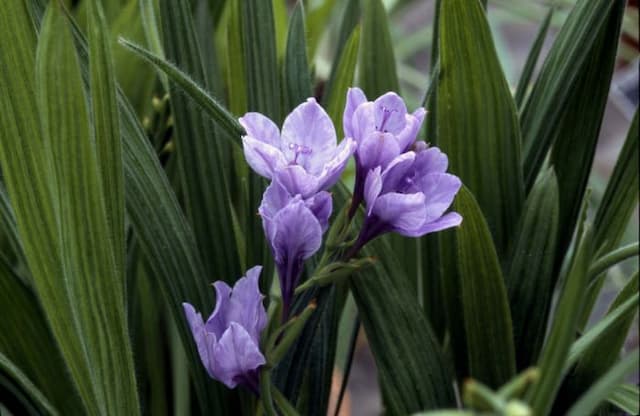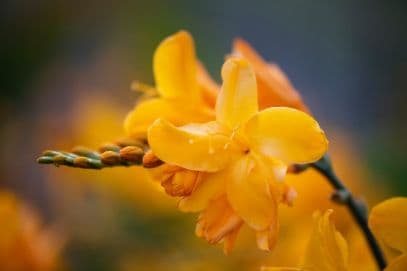Siberian Iris Iris 'Dreaming Spires' (Sib)

ABOUT
Iris 'Dreaming Spires' is a captivating garden plant known for its graceful blooms and elegant foliage. The most striking feature of this variety is its flowers. The blossoms exhibit warm tones of yellow, often with a richer golden hue or a bronze overlay. The flowers are composed of two distinct types of petals—standards and falls. The standards are the petals that stand upright, adding a regal height to the flower structure, while the falls are the downward-arching petals that create a sense of cascading color. Some varieties may present a delicate veining or intricate patterning on the petals, though the 'Dreaming Spires' is primarily known for its mono-colored petals. The leaves of the Iris 'Dreaming Spires' are slender, elongated, and sword-shaped, displaying a bright green color. They emerge in a fan-like arrangement, which creates an attractive, tidy clump in the garden. The foliage has a fresh, upright habit that supports the blooms and adds a vertical element to the landscape design. The overall impression of the Iris 'Dreaming Spires' is one of striking beauty and stately elegance, with the blooms held on strong, upright stems that rise above the foliage. The harmonious combination of color and form makes this iris a sought-after choice in gardens for its ornamental value and ability to draw the eye. The bloom time is typically in late spring or early summer, which contributes to its appeal as a seasonal highlight in the garden.
About this plant
 Names
NamesFamily
Iridaceae
Synonyms
Siberian Iris
Common names
Iris sibirica 'Dreaming Spires'.
 Toxicity
ToxicityTo humans
The plant commonly known as Siberian iris, specifically the variety 'Dreaming Spires', is not considered highly toxic to humans. However, like many iris species, it can cause mild stomach upset if ingested. Handling the plant may also cause skin irritation due to the presence of irisin, a substance found in the rhizomes. If any part of the plant is ingested, symptoms may include nausea, vomiting, abdominal pain, and diarrhea. It is always advised to avoid eating any plant parts if you are uncertain of their edibility or potential toxicity.
To pets
Siberian iris may cause mild to moderate digestive upset if ingested by pets. This can lead to symptoms such as drooling, vomiting, or diarrhea. The rhizomes contain irisin, a substance that can act as an irritant. While it is not considered highly toxic, ingestion of large quantities could lead to more serious symptoms and it is generally advisable to prevent pets from eating this plant. If you suspect your pet has ingested Siberian iris, it is recommended to consult your veterinarian.
 Characteristics
CharacteristicsLife cycle
Perennials
Foliage type
Deciduous
Color of leaves
Green
Flower color
Mixed
Height
2-3 feet (60-90 cm)
Spread
1-2 feet (30-60 cm)
Plant type
Herb
Hardiness zones
4
Native area
Siberia
Benefits
 General Benefits
General Benefits- Attractive Aesthetic: Adds beauty to the garden with its rich yellow blooms and tall, elegant stature.
- Pollinator Friendly: Attracts bees, butterflies, and other beneficial insects that help pollinate other plants.
- Low Maintenance: Requires minimal care once established, making it ideal for gardeners of all skill levels.
- Drought Tolerant: Once established, it can tolerate periods of dryness, reducing the need for frequent watering.
- Seasonal Interest: Provides spring and early summer interest with its flowering season.
- Versatile Landscaping: Can be used in borders, as a focal point, or as part of a mass planting for visual impact.
- Cold Hardy: Able to withstand cold winter temperatures, making it suitable for a range of climates.
- Deer and Rabbit Resistant: Typically not preferred by deer and rabbits, reducing the likelihood of damage from these animals.
 Medical Properties
Medical PropertiesThis plant is not used for medical purposes.
 Air-purifying Qualities
Air-purifying QualitiesThis plant is not specifically known for air purifying qualities.
 Other Uses
Other Uses- The tall, sturdy stalks of the Siberian iris can be used for supporting smaller, less stable plants in the garden.
- Siberian iris's fibrous roots can help stabilize soil and prevent erosion on slopes or in areas prone to heavy rains.
- The flowers of the Siberian iris, due to their unique shape and color, can be used in art classes for botanical drawing and watercolor painting.
- The dried seed pods of the Siberian iris add an interesting aesthetic to dried flower arrangements and winter bouquets.
- Its striking flowers can be used as a natural dye for fabrics, yielding subtle hues.
- The plant can be incorporated into sensory gardens as it provides an interesting texture and color contrast for sensory stimulation.
- Siberian iris can act as a natural pest deterrent; their thick clusters can be unappealing for small rodents looking for a nesting site.
- In photography, the Siberian iris, with its distinct form and coloration, makes an ideal subject for practicing depth of field and composition techniques.
- It can be used in wedding ceremonies as part of floral arrangements or as boutonnieres due to its elegant and distinctive appearance.
- The Siberian iris's resilience to cold temperatures makes it a good candidate for teaching about plant hardiness and adaptation in educational settings.
Interesting Facts
 Feng Shui
Feng ShuiThe Iris is not used in Feng Shui practice.
 Zodiac Sign Compitability
Zodiac Sign CompitabilityThe Iris is not used in astrology practice.
 Plant Symbolism
Plant Symbolism- Faith: The Iris often symbolizes faith, representing belief in something beyond oneself, which can be seen in the plant's upright stance, reaching towards the sky.
- Hope: Its resilient nature and ability to bloom year after year make the Iris a symbol of hope, indicating a positive expectation for the future.
- Wisdom: Historically, Irises were associated with royalty and the gods, particularly in ancient Egypt, thus it came to symbolize wisdom—a nod to the divine and enlightened guidance.
- Purity: The clear, striking colors of the Iris, especially the lighter shades, resonate with themes of purity and innocence.
- Courage: The bold appearance of the Iris 'Dreaming Spires' stands for courage, reflecting the plant's ability to grow in a variety of conditions and its striking spikes that pierce the garden's backdrop.
- Royalty: The rich hues and majestic bearing of the Iris are often seen as a representation of royalty and nobility, carrying an air of elegance and grandeur.
 Water
WaterSiberian Iris (Iris sibirica) ‘Dreaming Spires’ should be watered deeply to encourage the roots to grow downwards, making them more drought-tolerant. During the growing season, it's best to provide about an inch of water weekly, which translates to roughly 0.6 gallons for an average-sized garden. In periods of high heat or extreme dryness, you may need to water twice a week. Always check soil moisture before watering; the soil should be moist but not waterlogged. Cut back on watering once the plant has finished blooming and the foliage begins to yellow in the fall.
 Light
LightSiberian Iris prefers a location that receives full sun to partial shade. Ideally, it should get at least six hours of sunlight each day. The location should provide bright light but with some protection from the intense heat of the afternoon sun, which can scorch the foliage. Gardens with morning sun and afternoon shade are typically ideal settings for these irises.
 Temperature
TemperatureSiberian Iris thrives in a range of temperatures and is quite hardy, tolerating winter lows down to -40 degrees Fahrenheit. The plant performs best in spring and summer temperatures between 68 to 75 degrees Fahrenheit. Hot temperatures above 86 degrees Fahrenheit can hamper its growth and flowering, so it's crucial to provide some afternoon shade in warmer regions.
 Pruning
PruningPruning Siberian Iris involves the removal of dead or damaged foliage, which encourages healthy growth and can help prevent disease. Cut back the foliage in the fall, after it has died back naturally, to help clean up the plant and prepare it for winter. Typically, pruning should be done annually, during late fall or early winter, leaving about 4 to 5 inches of the foliage above the ground.
 Cleaning
CleaningAs needed
 Soil
SoilSiberian iris 'Dreaming Spires' requires well-draining, fertile soil with slight acidity to neutral pH, between 6.5 and 7.0. A mix with loamy soil, compost, and some coarse sand or perlite is ideal to facilitate good drainage and provide essential nutrients.
 Repotting
RepottingSiberian iris 'Dreaming Spires' generally does not need frequent repotting and can be replanted every 3 to 5 years or when the clumps become overcrowded. Divide clumps in late summer after flowering.
 Humidity & Misting
Humidity & MistingSiberian iris 'Dreaming Spires' is adaptable to a wide range of humidity conditions and does not require any special humidity requirements other than what is naturally provided in an outdoor environment.
 Suitable locations
Suitable locationsIndoor
Place in well-lit area and maintain moist soil.
Outdoor
Full sun to partial shade, moist, well-drained soil.
Hardiness zone
3-9 USDA
 Life cycle
Life cycleIris 'Dreaming Spires' begins its life cycle as a seed that germinates in moist but well-drained soil, usually in late winter to spring. The seed develops into a small plant with a rhizome, which is a horizontal stem that typically grows underground. It produces long, sword-shaped leaves and roots that spread out to establish the plant. Over time, this perennial form clumps as the rhizome divides and produces new shoots. Once mature, typically within 2 to 3 years, it blooms in late spring to early summer, displaying tall, elegant stalks with yellow flowers. After flowering, the plant goes into a dormancy period during the late summer to winter, conserving energy for the next season’s growth and reproduction.
 Propogation
PropogationPropogation time
Late Summer to Early Fall
Iris 'Dreaming Spires', commonly known as Siberian Iris, is typically propagated through division, a process best carried out in late summer to early fall after the flowering period has ended. This method involves carefully digging up the clumps of rhizomes and gently separating them by hand or with a sharp knife into smaller sections, making sure that each division has at least one healthy fan of leaves and a section of rhizome with roots. The divisions should be replanted at the same depth they were growing previously, spaced about 18 to 24 inches (approximately 45 to 60 centimeters) apart to allow ample room for growth. Planting in well-draining soil with moderate moisture is ideal for encouraging the development of strong, new plants that will continue to thrive and bloom in subsequent seasons.









